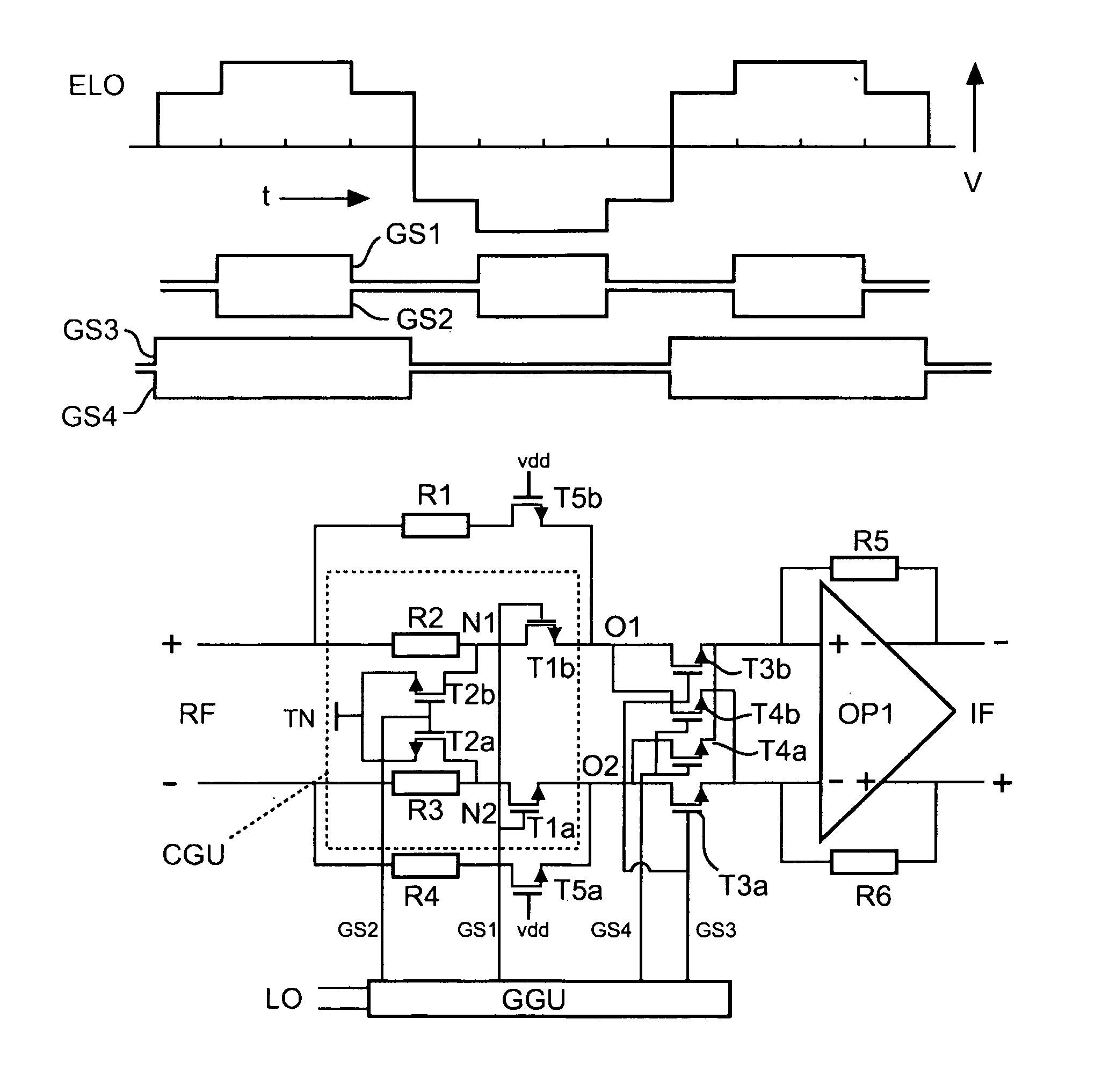Harmonic rejection mixer unit and method for performing a harmonic rejection mixing
a mixer unit and harmonic rejection technology, applied in the direction of instruments, electric/magnetic computing, computation using denominational number representation, etc., can solve the problems of affecting the linearity and affecting the performance of the mixer
- Summary
- Abstract
- Description
- Claims
- Application Information
AI Technical Summary
Benefits of technology
Problems solved by technology
Method used
Image
Examples
first embodiment
[0039]FIG. 4 shows a basic circuit diagram of a harmonic rejection mixer unit according to a In the upper part of FIG. 4, a diagram of gate signals GS1-GS4 and a resulting effective multiplication or local oscillator signal ELO of the harmonic rejection mixer is shown. The gate signals GS1-GS4 are derived from the local oscillator signal LO. The time period of the gate signal GS1 corresponds to the time period of the gate signal GS2 and is ½ of the time period of the LO or multiplication signal. However, the gate signal GS2 is inverted with respect to the gate signal GS1. The time period of the gate signal GS3 corresponds to the time period of the gate signal GS4 as well as to the time period of the LO signal. However, the gate signal GS4 is inverted with respect to the gate signal GS3.
[0040]The effective LO or multiplication signal described according to the present invention can be measured at the IF output, if a DC voltage is applied to a RF input. The effective LO or multiplica...
second embodiment
[0051]FIG. 5 shows a schematic representation of a harmonic rejection mixer according to a In the upper part of FIG. 5, a diagram of the effective local oscillator LO or the multiplication signal ELO and the gate signals GS2-GS4 are depicted. The gate signals GS2-GS4 are derived from LO signal in the gate signal generating unit GGU and can be applied to different transistor units of the harmonic rejection mixer unit. The time period of the gate signal GS2 corresponds to ½ of time period of the LO signal. The time period of the gate signal GS3 corresponds to the time period of the gate signal GS4 as well as to the time period of the LO signal. However, the gate signal GS4 is time-shifted with respect to the gate signal GS3. Compared to the original 50% duty cycle of the LO signal the duty cycle of the gate signals are reduced.
[0052]In the lower part of FIG. 5, a circuit diagram of the harmonic rejection mixer according to the second embodiment is depicted. The harmonic rejection mix...
sixth embodiment
[0069]FIG. 9 shows a block diagram of a harmonic rejection mixer according to a While in FIG. 5 a circuit diagram of the harmonic rejection mixer is depicted, FIG. 9 shows a block diagram of the harmonic rejection mixer. The harmonic rejection mixer comprises an input TN, a plurality of voltage-to-current units with different gain V21G1-V21GN, coupled to the input IN and in series with a plurality of harmonic rejection units HRU1-HRUN (wherein each V21 unit is associated with a harmonic rejection unit HRU) and a current to voltage unit 12V. The outputs of the harmonic rejection units HRU1-HRUN are summed or combined and the result thereof is input to the current-to-voltage unit 12V. The output of the current to voltage unit 12V constitutes the output of the harmonic rejection mixer. The harmonic rejection mixer furthermore comprises a transistor control signal generating unit GGU for generating transistor control signals for controlling transistors in the harmonic rejection units H...
PUM
 Login to View More
Login to View More Abstract
Description
Claims
Application Information
 Login to View More
Login to View More - R&D
- Intellectual Property
- Life Sciences
- Materials
- Tech Scout
- Unparalleled Data Quality
- Higher Quality Content
- 60% Fewer Hallucinations
Browse by: Latest US Patents, China's latest patents, Technical Efficacy Thesaurus, Application Domain, Technology Topic, Popular Technical Reports.
© 2025 PatSnap. All rights reserved.Legal|Privacy policy|Modern Slavery Act Transparency Statement|Sitemap|About US| Contact US: help@patsnap.com



